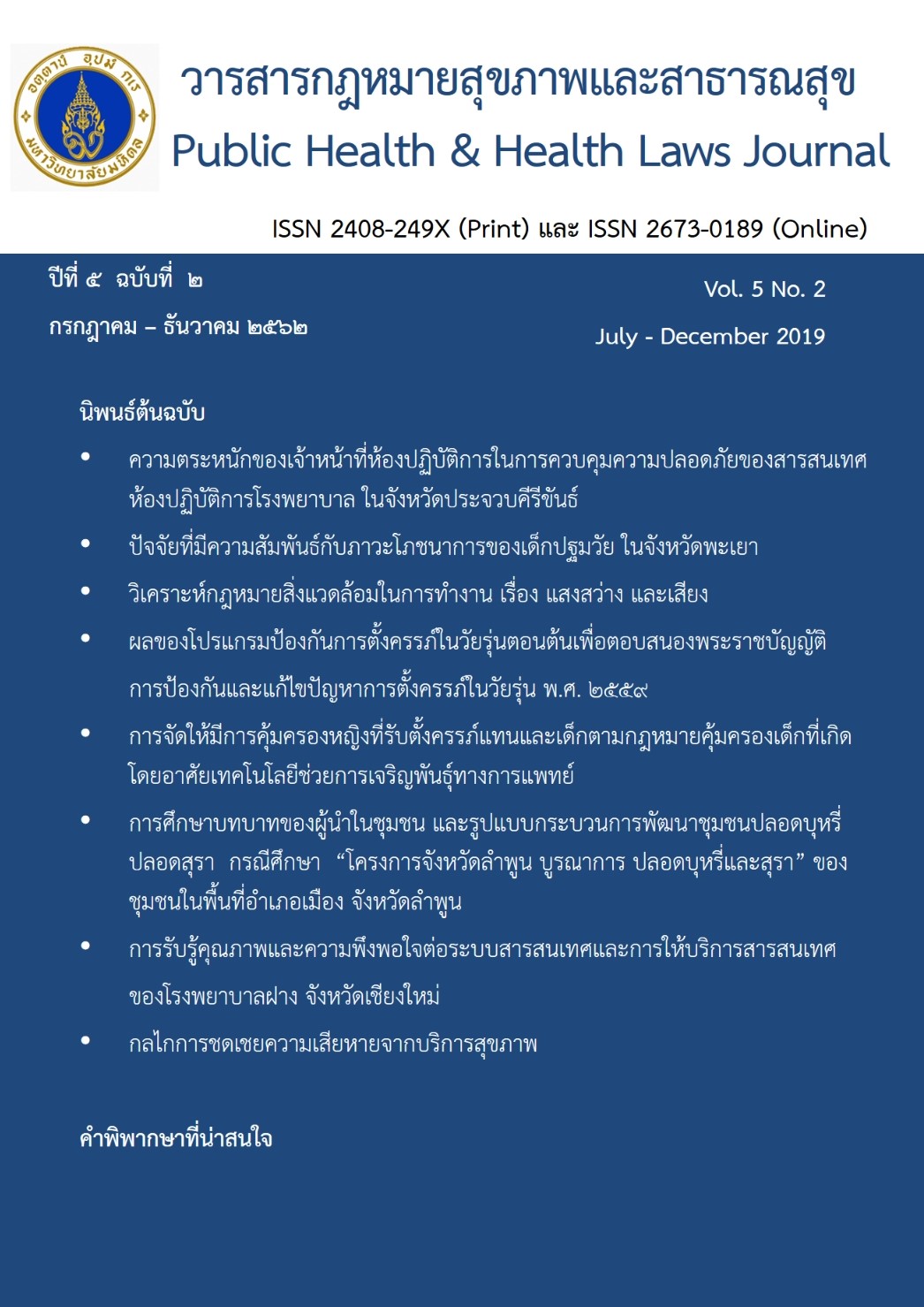The Compensation Mechanism of Adverse Event in Thai Healthcare
Keywords:
medical error, medical malpractice, medical adverse event, no-fault compensation in healthcare, healthcare compensation mechanismAbstract
This research uses mixed method. The objectives were to gather the detection suffering of Thai’ people who have been damaged by using the healthcare services in the public and private sectors; to analyze the basic compensation mechanism, including the criteria and procedures of the mechanism; to study the scope of compensation for damages from the healthcare services; to study the potential of the source of money in the mechanism; and to suggest a draft policy and law on compensation for damage from healthcare services in Thailand.
Results found that the healthcare service providers avoided clarifying the circumstances and causes of damage to the injured person or relatives. Approval of the amount of compensation was delayed and did not comply with the conditions. Lack of compensation to remedy the impact on the victims' families after the accident. Most health staff did not understand the concepts, methods and procedures for compensation mechanism of the damages. The victims lack knowledge and understanding of compensation mechanisms. Medical records were difficult for accessibility were and modified, destroyed or concealed. Recommendations: 1) Philosophy, concepts, objectives for no-fault compensation mechanisms should be implemented by the administration. 2) Scope of enforcement should cover all types of public health services 3) Organization and authority should be a government agency with an independence body 4) The source of funds should come from many sectors of society, 5) the criteria for payment should pay to cover damages caused by complications and from the healthcare service system faults 6) the scope of payment should be paid according to the type of damage 7) the process for consideration should be submitted in writing to the provincial level offices in every province or at the district level. The request must be considered promptly 8) The right to judicial system should not be deprived 9) There should be measures to develop patients’ safety system. 10) Measures to supplement the drafted policy and law of the mechanism (before reaching judicial system), should have an arbitration system to mediate the damages.
References
ปัตพงษ์ เกษสมบูรณ์ และ ศุภสิทธิ์ พรรณารุโณทัย (2548) “ทางเลือกเพื่อออกแบบระบบชดเชยความเสียหายแก่ผู้ปวย” วารสารวิชาการสาธารณสุข 14 ฉบับที่ 6 พฤษภาคม –ธันวาคม 2548 หน้า 941-954.
ปัตพงษ์ เกษตสมบูรณ์, ศุภสิทธิ์ พรรณารุโณทัย,วีระศักดิ์ จงสู่วิวัฒน์วงศ์ และประดิษฐ์ วงษ์คณารัตนกูล, (2549) การพัฒนาเครื่องมือและกระบวนการวินิจฉัยภาวะไม่พึงประสงค์ที่เกิดขึ้นในโรงพยาบาล: บทสังเคราะห์ทางนโยบาย เรื่อง ทางเลือกเพื่อการออกแบบระบบการชดเชยความเสียหายแก่ผู้ป่วย, ภาคผนวก 6, สถาบันวิจัยระบบสาธารณสุข
ประมวลกฎหมายแพ่งและพาณิชย์ พุทธศักราช (2468) ราชกิจจานุเบกษา เล่ม 169/ตอนที่ 42/หน้า 1/8 เมษายน 2535 และฉบับแก้ไขเพิ่มเติม
พระราชบัญญัติเงินทดแทน พ.ศ. 2537,ราชกิจจานุเบกษา เล่ม 111/ตอนที่ 28 ก/หน้า 3/30 มิถุนายน 2537;ราชกิจจานุเบกษา เล่ม 119/ตอนที่ 102 ก/หน้า 66/8 ตุลาคม 2545
พระราชบัญญัติความรับผิดทางละเมิดของเจ้าหน้าที่ พ.ศ. 2539, ราชกิจจานุเบกษา เล่ม 113/ตอนที่ 60 ก/หน้า 25/14 พฤศจิกายน 2539
พระราชบัญญัติหลักประกันสุขภาพแห่งชาติ พ.ศ. 2545, ราชกิจจานุเบกษา เล่ม 119/ตอนที่ 116 ก/หน้า 1/18 พฤศจิกายน 2545
พระราชบัญญัติอนุญาโตตุลาการ พ.ศ. 2545, ราชกิจจานุเบกษา เล่ม 119/ตอนที่ 39 ก/หน้า 1/29 เมษายน 2545
ลือชัย ศรีเงินยวง, นฤพงศ์ ภักดี และ และ จิราภร ชมศรี, (2548) “การชดเชยความเสียหายจากบริการทางการแพทย์โดยไม่ต้องรับผิด: การทบทวนประสบการณ์ใน 6 ประเทศ, คณะสังคมศาสตร์และมนุษยศาสตร์ มหาวิทยาลัยมหิดล
ลือชัย ศรีเงินยวง และคณะ, (2548) “การศึกษาติดตามและประเมินผลกระทบของนโยบายและการดําเนินการจ่ายเงินช่วยเหลือเบื้องต้นตามมาตรา 41” ศูนย์วิจัยสังคมคณะสังคมศาสตร์และมนุษย์ศาสตร์ มหาวิทยาลัยมหิดล
ศุภศิทธิ์ พรรณานุโรทัย, ดิเรก ปัทมิริวัฒน์ และสัมฤทธิ์ ศรีธำรงค์สวัสดิ์, (2547) ความเป็นไปได้และทางเลือกของระบบการคลังเพื่อหลักประกันสุขภาพถ้วนหน้าในประเทศไทย รายงานวิจัยของสำนักงานโครงการปฏิรูประบบบริการสาธารณสุข. สปสช.
สมหญิง สายธนู รัชตะ ตั้งศิริพัฒน์ วงเดือน จินดาวัฒนะ วิโรจน์ ตั้งเจริญเสถียร. (2546). การจัดการความรับผิดจากการรักษาทางการแพทย์. วารสารวิชาการสาธารณสุข 12:876-88.
B. von Eyben, (2002). Alternative compensation mechanisms for damages. The Nordic countries Denmark, Finalnd, Norway, Sweden. Common report and national reports, AIDA XIth World congres. New York 22-25 October
Bismark M, Paterson R, (2006). No-Fault Compensation in New Zealand:Harmonizing Injury Health Affairs January/February 25(1):278–83 Full text is available at: http://content.healthaffairs.org/cgi/content/full/25/1/278?ijkey=E13G6melb5wfU&keytype=ref&siteid=healthaff
Denzon, Paticia, M.Tort Reform: The Case of Medical Malpractice. Oxford Review of Economic Policy. 1994 Mar; 10 (1):84-99.
Dute J, Faure GM, and Koziol H, Comparative. No-Fault Compensation in the Health Care Sector : Comparative Reports and Conclusions, Tort and Insurance Law Vol.8. Year,2004.
Linda T. Kohn, Janet M. Corrigan, and Molla S. Donalds, (2000) To Err Is Human: Building a Safer Health System Washington, D.C.: NATIONAL ACADEMY ; 40 (available at http://www.nap.edu/catalog/9728.html)
Rolph E, Moller E, Rolph JE. Arbitration Agreements in Health Care: Myths and Reality. Law and Contemporary Problems. Winter/Spring 1997; 60:153-186.
Sirur SP. Consumer courts. Indian J Dermatol Venereol Leprol [serial online] 2004 [cited 2007 Oct 15];70:52-53. Available from: http://www.ijdvl.com/text.asp?2004/70/1/52/6825
Studdert, D.M. and Brennan, T.A No-fault compensation for medicine injuries: the prospect for error prevention. JAMA.2001 Jul 11; 286(2):217-23.
Downloads
Published
How to Cite
Issue
Section
License
Disclaimer and Copyright Notice
The content and information presented in articles published in the Journal of Law and Public Health Policy represent the opinions and sole responsibility of the respective authors. The editorial board does not necessarily agree with or assume any responsibility for the views expressed.
All articles, data, content, images, and other materials published in the Journal of Law and Public Health Policy are the intellectual property of the journal. Any individual or organization wishing to reproduce, distribute, or otherwise use the entirety or any part of such materials must provide proper citation.





